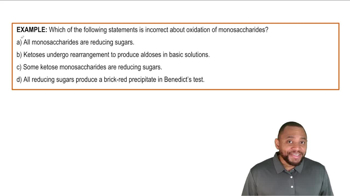How many moles of ATP are produced by phosphorylation in the following?
b. Aerobic conversion of 1 mol of pyruvate to 1 mol of acetyl-CoA
 Verified step by step guidance
Verified step by step guidance

How many moles of ATP are produced by phosphorylation in the following?
b. Aerobic conversion of 1 mol of pyruvate to 1 mol of acetyl-CoA
How many moles of ATP are produced by phosphorylation in the following?
c. Catabolism of 1 mol of acetyl-CoA in the citric acid cycle
Lactate can be converted into pyruvate by the enzyme lactate dehydrogenase and the coenzyme NAD⁺. Write the reaction in the standard biochemical format, using a curved arrow to show the involvement of NAD⁺.
In Figure 22.3, compare the starting compound (glucose) and the final product (pyruvate).
a. Which is oxidized to a greater extent?
Why does glycogenolysis use fewer steps than the reverse process, glycogenesis? Which process uses less energy?
Name the anabolic pathway for making glucose.